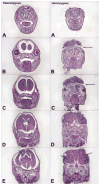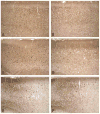Neurodevelopmental effects of insulin-like growth factor signaling
- PMID: 22710100
- PMCID: PMC3677055
- DOI: 10.1016/j.yfrne.2012.06.002
Neurodevelopmental effects of insulin-like growth factor signaling
Abstract
Insulin-like growth factor (IGF) signaling greatly impacts the development and growth of the central nervous system (CNS). IGF-I and IGF-II, two ligands of the IGF system, exert a wide variety of actions both during development and in adulthood, promoting the survival and proliferation of neural cells. The IGFs also influence the growth and maturation of neural cells, augmenting dendritic growth and spine formation, axon outgrowth, synaptogenesis, and myelination. Specific IGF actions, however, likely depend on cell type, developmental stage, and local microenvironmental milieu within the brain. Emerging research also indicates that alterations in IGF signaling likely contribute to the pathogenesis of some neurological disorders. This review summarizes experimental studies and shed light on the critical roles of IGF signaling, as well as its mechanisms, during CNS development.
Copyright © 2012 Elsevier Inc. All rights reserved.
Figures





Similar articles
-
The insulin-like growth factor system and cancer.Cancer Lett. 2003 Jun 10;195(2):127-37. doi: 10.1016/s0304-3835(03)00159-9. Cancer Lett. 2003. PMID: 12767520 Review.
-
Genetics, chemistry, and function of the IGF/IGFBP system.Endocrine. 2000 Apr;12(2):121-36. doi: 10.1385/ENDO:12:2:121. Endocrine. 2000. PMID: 10905372 Review. No abstract available.
-
Insulin-like growth factors and skeletal growth: possibilities for therapeutic interventions.J Clin Endocrinol Metab. 1999 Dec;84(12):4349-54. doi: 10.1210/jcem.84.12.6201. J Clin Endocrinol Metab. 1999. PMID: 10599687 Review. No abstract available.
-
Insulin-like growth factors.Biol Signals. 1992 Jul-Aug;1(4):173-81. doi: 10.1159/000109323. Biol Signals. 1992. PMID: 1307923 Review.
-
Regulation of insulin-like growth factors and IGF-binding proteins in bone tumours.Growth Regul. 1996 Mar;6(1):10-5. Growth Regul. 1996. PMID: 8717445 Review.
Cited by
-
Growth hormone and cognitive function.Nat Rev Endocrinol. 2013 Jun;9(6):357-65. doi: 10.1038/nrendo.2013.78. Epub 2013 Apr 30. Nat Rev Endocrinol. 2013. PMID: 23629538 Review.
-
Neuroprotective effects of insulin-like growth factor-2 in 6-hydroxydopamine-induced cellular and mouse models of Parkinson's disease.Neural Regen Res. 2023 May;18(5):1099-1106. doi: 10.4103/1673-5374.355815. Neural Regen Res. 2023. PMID: 36254999 Free PMC article.
-
The Effects of Four Weeks of Chiropractic Spinal Adjustments on Blood Biomarkers in Adults with Chronic Stroke: Secondary Outcomes of a Randomized Controlled Trial.J Clin Med. 2022 Dec 17;11(24):7493. doi: 10.3390/jcm11247493. J Clin Med. 2022. PMID: 36556107 Free PMC article.
-
KIF1Bβ mutations detected in hereditary neuropathy impair IGF1R transport and axon growth.J Cell Biol. 2018 Oct 1;217(10):3480-3496. doi: 10.1083/jcb.201801085. Epub 2018 Aug 20. J Cell Biol. 2018. PMID: 30126838 Free PMC article.
-
Altered insulin-like growth factor-2 signaling is associated with psychopathology and cognitive deficits in patients with schizophrenia.PLoS One. 2020 Mar 19;15(3):e0226688. doi: 10.1371/journal.pone.0226688. eCollection 2020. PLoS One. 2020. PMID: 32191705 Free PMC article.
References
-
- Aberg MA, Aberg ND, Palmer TD, Alborn AM, Carlsson-Skwirut C, Bang P, Rosengren LE, Olsson T, Gage FH, Eriksson PS. IGF-I has a direct proliferative effect in adult hippocampal progenitor cells. Mol Cell Neurosci. 2003a;24:23–40. - PubMed
-
- Aberg ND, Blomstrand F, Aberg MA, Bjorklund U, Carlsson B, Carlsson-Skwirut C, Bang P, Ronnback L, Eriksson PS. Insulin-like growth factor-I increases astrocyte intercellular gap junctional communication and connexin43 expression in vitro. J Neurosci Res. 2003b;74:12–22. - PubMed
-
- Aberg ND, Johansson UE, Aberg MA, Hellstrom NA, Lind J, Bull C, Isgaard J, Anderson MF, Oscarsson J, Eriksson PS. Peripheral infusion of insulin-like growth factor-I increases the number of newborn oligodendrocytes in the cerebral cortex of adult hypophysectomized rats. Endocrinology. 2007;148:3765–3772. - PubMed
-
- Abuzzahab MJ, Schneider A, Goddard A, Grigorescu F, Lautier C, Keller E, Kiess W, Klammt J, Kratzsch J, Osgood D, Pfaffle R, Raile K, Seidel B, Smith RJ, Chernausek SD. IGF-I receptor mutations resulting in intrauterine and postnatal growth retardation. New Engl J Med. 2003;349:2211–2222. - PubMed
Publication types
MeSH terms
Substances
Grants and funding
LinkOut - more resources
Full Text Sources

